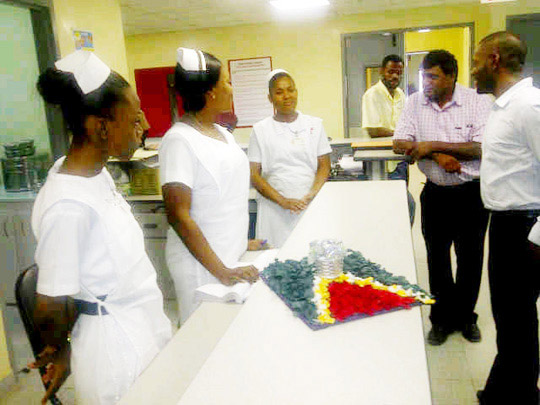The $5M burner at the Linden Hospital Complex (LHC) remains out of service even as ‘sharps’ –needles, scalpels and other sharp-edged instruments used in the facility- are piling up.
More than eight months’ worth of ‘sharps’ are waiting to be destroyed while sections of the complex are falling apart.

These issues as well as the absence of some key facilities necessary for the proper functioning of the $2.2 billion institution were highlighted by councillor and head of the Regional Democratic Council (RDC) health committee, Maurice Butters at a recent sitting of the RDC. Butters has been a longstanding senior union representative and employee (now retired) of the LHC.
Butters was later accompanied by Regional Chairman Kuice Sharma Solomon for a site visit where they had a walk through and brief discussions with acting Chief Executive Officer Dr Farouk Riyasat, head of maintenance Rupert McLean and other key staff of the department as well as nurses.
The non-functioning of the burner, which has been out of operation for over eight months, was highlighted and according to employees, currently sharps are crammed into two rooms but they are running out of space.
Walking past one of the rooms where the sharps are stored, one is hit by the foul scent which worsens when the doors were opened, revealing the crammed room with hundreds of containers of used sharps.
Behind the room there is a large heap of garbage between the non functional burner and the incinerator. Like the burner, the incinerator is out of service and according to the staff, they are forced to burn the garbage on a daily basis. The room filled with the sharps, the garbage heap, non functional incinerator and the burner are less than ten feet from the Demerara River which divides Mackenzie from Wismar.
The scent has affected those living in nearby West Watooka. “The people who are living just over there have complained to me that the stench that comes from the burning of the hospital garbage cause them to feel bad, nauseated,” the regional chairman said.
According to Dr. Riyasat and McLean the situation was reported to the authorities and an engineer visited some months ago. “But since then there has been no further action.
He (the engineer) said that he is the only health engineer for the country so he has to be travelling the whole country to look at hospital problems,” said Dr. Riyasat.
During the tour of the hospital concerns were raised about the integrity of the structure.
According to the staff, an employee narrowly escaped serious injury after several blocks from an upper section of the building came crashing down ripping through the ceiling in the x-ray department.
According to the maintenance crew, upon investigation it was discovered that a section of the building which was laid in blocks was not plastered. “Thank God that person managed to move quickly. When we got up there we had to plaster that section because it appears as though they had forgotten to plaster that section,” an employee said. At the time, new funds were used for the repairs since the defects liability period had expired.
The plumbing system was also criticized by management who said that the maintenance team is forced to spend endless hours to re-work the system. “Just recently the x-ray unit had to be shut down for three days. While the management was furnished with maps for the ground piping, none was provided for the overhead systems,” an official said.
In addition, for the past three years an ultrasound machine has been sitting uselessly at the LHC awaiting the provision of a missing part. The multi-million dollar boiler system is also not working. “So you can well picture the hospital without a hot water system,” said a senior nurse.
There was evidence of cracks in the walls in several sections of the building and according to the hospital management it was the first time that the contractor had undertaken a building of such magnitude.
The regional authorities and management of the LHC expressed concern that the institution is yet to be equipped with some key components. The absence of an intensive care unit and ultrasound machine were two of the major concerns. Nurses and Dr. Riyasat all decried the existing conditions they are made to work under.
HDU
“Right now we have a thing that looks like a HDU (high dependency unit). Certain equipment we have to be borrowing from the A&E department. What happens when they have an emergency and we have a serious patient up here, we have to compromise the care of our patient,” questioned a nurse.
They also spoke to the need for blood pressure sets as the existing ones frequently malfunction.
At the time of the team’s visit there were three registered nurses on duty in the HDU. “None of us are trained ICU nurses. We are only trying to fill in. We need to be trained so we can effectively deliver the best health care to our patients,” one said. Another explained that currently there are only two nurses training the ICU nurses and there is also an urgent need for more anesthesiologists.
In 2009 the $2.2 billion institution was commissioned minus some of the initially planned equipment, facilities and departments. While the building houses rooms which are not used, others were never built.
The team was told that contrary to the initial plan, large sums of monies were diverted for the driving of piles and the purchasing of buildings and land. “It was recommended that this was not the best site for this hospital. The other area that was recommended they would not have had to drive pile or purchase any land and building and those monies would have gone to making this facility a real state-of-the-art place,” said an official.





